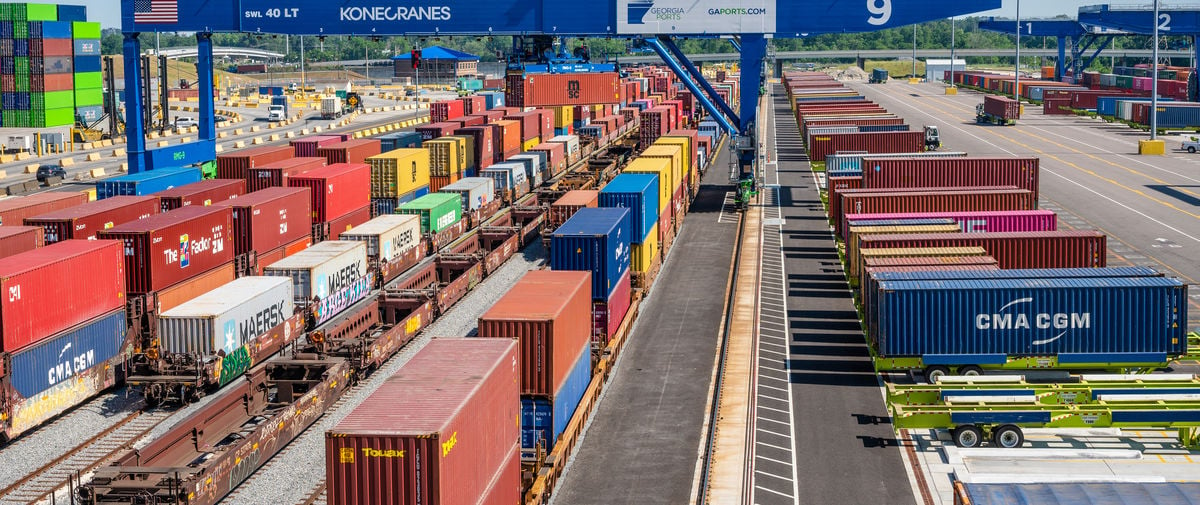Globalization is here to stay. As part of that, the everyday goods and foods that we enjoy and need as our daily comforts are available to us thanks to the complex and global journeys these products and their components have been on.
Almost everything you could think of, some 95% of all manufactured goods, has at some point been moved in standardized shipping containers, collected from fields and factories and transported to inland logistics hubs and on to seaside container terminals for shipping abroad. Passing over oceans and seas on container ships, the goods arrive at their destination seaport where the journey continues – unloading, short-term storage in container yards, placing onto road trucks or trains, moving to inland intermodal terminals, and finally on to shops and homes.
It’s a complex chain with many handovers entailing a huge amount of cooperation, on a global scale – and has a key role in keeping national economies moving. With so much at stake, efficiency, smart technology and sustainability, all interrelated, are a must-have in this logistical system to avoid costly delays and breakdowns. This is sustainable material handling, something that Konecranes, a global material-handling and lifting company, specializes in.
Intermodal terminals: the inland logistics players
The global logistics chain of container handling has two parts: transport across seas and oceans, and inland transport. For the latter, intermodal terminals are the key players, giving seamless transitions between modes of inland transport. Intermodal terminals receive and distribute containers from road trucks, trains, sometimes river barges, swapping between these modes of transportation as required by the end destination.
Efficiency is paramount at intermodal terminals – if there is unscheduled wait-time for a container, costs mount across the inland supply chain.
“Improving the intermodal inland part of the global logistics chain depends on making container handling equipment smarter, so it does the heavy lifting more efficiently and generates real-time data on operations,” Stephan Stiehler, Sales Director Intermodal at Konecranes, explains and adds: “When it comes to eco-efficiency, the sooner all mobile equipment becomes battery-driven, the better. And automation technology can do much more to make intermodal operations smarter and more efficient.”
Taking the leap to battery-driven vehicles
The electrification of container handling equipment, which has traditionally relied on diesel fossil fuel, is an essential part of meeting ever-tighter environmental regulations in ports. There is a worldwide movement to make this transition and Konecranes is at the forefront of it.
For example, Konecranes Automated Guided Vehicles (AGVs) were the first container handling machines to transition to fully-electric operation. The large container terminal Hamburg Hafen und Logistik AG in Germany has been a front-runner in adopting battery-driven AGVs. Its Konecranes Gottwald AGV fleet is now completely driven by Li-ion batteries, far superior to the lead-acid batteries previously used.
“Konecranes keeps a sharp eye on the development of sustainability requirements and builds it into its product development process. Lithium-ion battery technology has enabled big improvements, and there is more to come,” said Jan Schmidt-Ewig, Product Manager in Horizontal Transport, Konecranes.
Improving container handling with automation
Automation is the next evolutionary trend in improving container handling – something Konecranes knows a lot about as the leading container handling automation supplier, with 65% of automated container terminals around the world running with Konecranes.
There is huge potential here to increase efficiency, safety, profitability and reduce emissions. “Today, only around 5% of container terminals worldwide are fully automated. Twenty years from now, one way or another, the vast majority of larger container terminals will be fully automated or semi-automated using fully electric container handling equipment. This will be a win-win for business and the environment,” said Thomas Gylling, Director of Marketing & Customer Experience, Port Solutions, Konecranes.
Making sustainable material handling a priority
Globalization is here to stay with consumers all over the world relying on easy access to a vast array of products as part of their everyday lives – and the global logistics chain of container handling is the backbone that makes it possible. The food you eat, your digital devices, your clothing, your transportation – all of these products and the components comprising them have travelled a long distance to enable us to live the lives we are now accustomed to.
The way our everyday is supplied must transform, however, as the fight against climate change ramps up. As part of this there is a global mission to decrease the CO2 emissions generated at every link in the global supply chain. Konecranes has an important role to play here, leading the way with new, more sustainable material handling technologies and demonstrably sustainable business practices.
» Learn more about Konecranes Port Solutions
